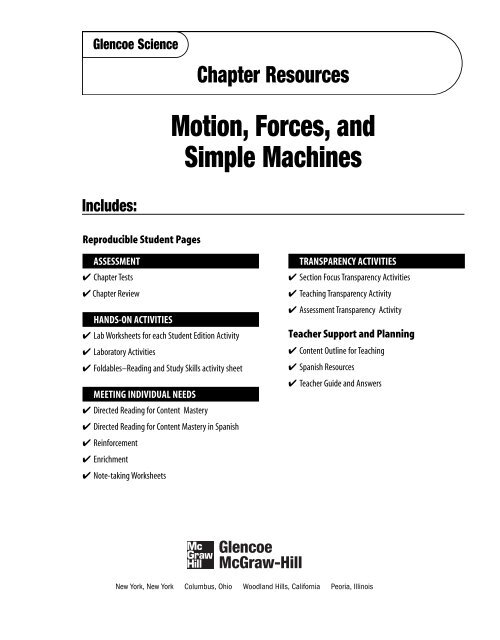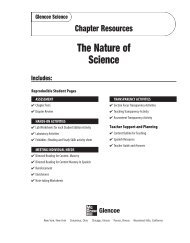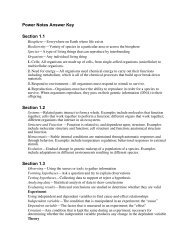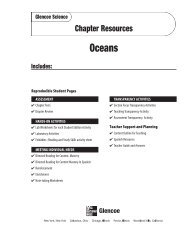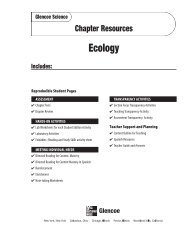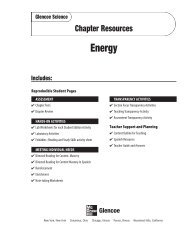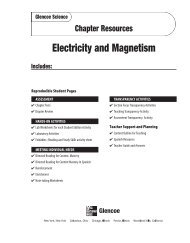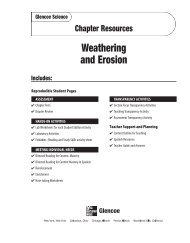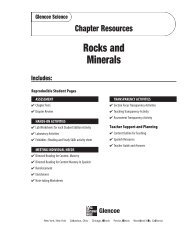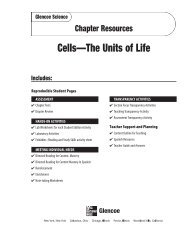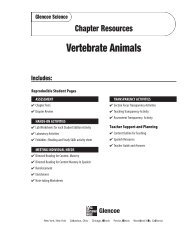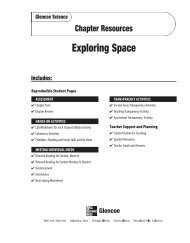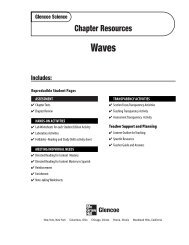Chapter 5 Resource: Motion, Forces, and Simple Machines
Chapter 5 Resource: Motion, Forces, and Simple Machines
Chapter 5 Resource: Motion, Forces, and Simple Machines
Create successful ePaper yourself
Turn your PDF publications into a flip-book with our unique Google optimized e-Paper software.
Glencoe Science<strong>Chapter</strong> <strong>Resource</strong>s<strong>Motion</strong>, <strong>Forces</strong>, <strong>and</strong><strong>Simple</strong> <strong>Machines</strong>Includes:Reproducible Student PagesASSESSMENT✔ <strong>Chapter</strong> Tests✔ <strong>Chapter</strong> ReviewHANDS-ON ACTIVITIES✔ Lab Worksheets for each Student Edition Activity✔ Laboratory Activities✔ Foldables–Reading <strong>and</strong> Study Skills activity sheetMEETING INDIVIDUAL NEEDS✔ Directed Reading for Content Mastery✔ Directed Reading for Content Mastery in Spanish✔ Reinforcement✔ Enrichment✔ Note-taking WorksheetsTRANSPARENCY ACTIVITIES✔ Section Focus Transparency Activities✔ Teaching Transparency Activity✔ Assessment Transparency ActivityTeacher Support <strong>and</strong> Planning✔ Content Outline for Teaching✔ Spanish <strong>Resource</strong>s✔ Teacher Guide <strong>and</strong> Answers
Glencoe SciencePhoto CreditsSection Focus Transparency 1: UNIVERSAL PRESS SYNDICATESection Focus Transparency 2: G. Savage/V<strong>and</strong>tstadt/Photo ResearchersSection Focus Transparency 3: Jeff Greenberg/Visuals UnlimitedTeaching Transparency: (t) Lew Long/The Stock Market, (cl) Bob Daemmrich, (cr) Bob Daemmrich,(b) Gregg Otto/Visuals UnlimitedCopyright © by The McGraw-Hill Companies, Inc. All rights reserved.Permission is granted to reproduce the material contained herein on the conditionthat such material be reproduced only for classroom use; be provided to students,teachers, <strong>and</strong> families without charge; <strong>and</strong> be used solely in conjunction with the<strong>Motion</strong>, <strong>Forces</strong>, <strong>and</strong> <strong>Simple</strong> <strong>Machines</strong> program. Any other reproduction, for useor sale, is prohibited without prior written permission of the publisher.Send all inquiries to:Glencoe/McGraw-Hill8787 Orion PlaceColumbus, OH 43240-4027ISBN 0-07-867198-1Printed in the United States of America.1 2 3 4 5 6 7 8 9 10 079 09 08 07 06 05 04
Table of ContentsTo the TeacherivReproducible Student Pages■ H<strong>and</strong>s-On ActivitiesMiniLAB: Try at Home Determining Weights in Newtons . . . . . . . . . . . . . . . . . . . . . . . . . . . . . . . . . . . 3MiniLAB: Observing Mechanical Advantage–Pulleys. . . . . . . . . . . . . . . . . . . . . . . . . . . . . . . . . . . . . . . . 4Lab: <strong>Motion</strong> . . . . . . . . . . . . . . . . . . . . . . . . . . . . . . . . . . . . . . . . . . . . . . . . . . . . . . . . . . . . . . . . . . . . . . . . . 5Lab: Use the Internet Methods of Travel . . . . . . . . . . . . . . . . . . . . . . . . . . . . . . . . . . . . . . . . . . . . . . . . . . 7Laboratory Activity 1: Speed of Falling Objects . . . . . . . . . . . . . . . . . . . . . . . . . . . . . . . . . . . . . . . . . . . . 9Laboratory Activity 2: Newton’s First Law of <strong>Motion</strong> . . . . . . . . . . . . . . . . . . . . . . . . . . . . . . . . . . . . . . 13Foldables: Reading <strong>and</strong> Study Skills . . . . . . . . . . . . . . . . . . . . . . . . . . . . . . . . . . . . . . . . . . . . . . . . . . . . 15■ Meeting Individual NeedsExtension <strong>and</strong> InterventionDirected Reading for Content Mastery . . . . . . . . . . . . . . . . . . . . . . . . . . . . . . . . . . . . . . . . . . . . . . . . . 17Directed Reading for Content Mastery in Spanish . . . . . . . . . . . . . . . . . . . . . . . . . . . . . . . . . . . . . . . . 21Reinforcement . . . . . . . . . . . . . . . . . . . . . . . . . . . . . . . . . . . . . . . . . . . . . . . . . . . . . . . . . . . . . . . . . . . . . 25Enrichment . . . . . . . . . . . . . . . . . . . . . . . . . . . . . . . . . . . . . . . . . . . . . . . . . . . . . . . . . . . . . . . . . . . . . . . . 28Note-taking Worksheet . . . . . . . . . . . . . . . . . . . . . . . . . . . . . . . . . . . . . . . . . . . . . . . . . . . . . . . . . . . . . . 31■ Assessment<strong>Chapter</strong> Review. . . . . . . . . . . . . . . . . . . . . . . . . . . . . . . . . . . . . . . . . . . . . . . . . . . . . . . . . . . . . . . . . . . . . 35<strong>Chapter</strong> Test . . . . . . . . . . . . . . . . . . . . . . . . . . . . . . . . . . . . . . . . . . . . . . . . . . . . . . . . . . . . . . . . . . . . . . . 37■ Transparency ActivitiesSection Focus Transparency Activities . . . . . . . . . . . . . . . . . . . . . . . . . . . . . . . . . . . . . . . . . . . . . . . . . . 42Teaching Transparency Activity . . . . . . . . . . . . . . . . . . . . . . . . . . . . . . . . . . . . . . . . . . . . . . . . . . . . . . . 45Assessment Transparency Activity . . . . . . . . . . . . . . . . . . . . . . . . . . . . . . . . . . . . . . . . . . . . . . . . . . . . . 47Teacher Support <strong>and</strong> PlanningContent Outline for Teaching. . . . . . . . . . . . . . . . . . . . . . . . . . . . . . . . . . . . . . . . . . . . . . . . . . . . . . . . . T2Spanish <strong>Resource</strong>s . . . . . . . . . . . . . . . . . . . . . . . . . . . . . . . . . . . . . . . . . . . . . . . . . . . . . . . . . . . . . . . . . . T5Teacher Guide <strong>and</strong> Answers . . . . . . . . . . . . . . . . . . . . . . . . . . . . . . . . . . . . . . . . . . . . . . . . . . . . . . . . . . T9Additional Assessment <strong>Resource</strong>s available with Glencoe Science:• ExamView ® Pro Testmaker• Assessment Transparencies• Performance Assessment in the Science Classroom• St<strong>and</strong>ardized Test Practice Booklet• MindJogger Videoquizzes• Vocabulary PuzzleMaker at msscience.com• Interactive Chalkboard• The Glencoe Science Web site at: msscience.com• An interactive version of this textbook along with assessment resources are availableonline at: mhln.comiii
To the TeacherThis chapter-based booklet contains all of the resource materials to help you teachthis chapter more effectively. Within you will find:Reproducible pages for■ Student Assessment■ H<strong>and</strong>s-on Activities■ Meeting Individual Needs (Extension <strong>and</strong> Intervention)■ Transparency ActivitiesA teacher support <strong>and</strong> planning section including■ Content Outline of the chapter■ Spanish <strong>Resource</strong>s■ Answers <strong>and</strong> teacher notes for the worksheetsH<strong>and</strong>s-On ActivitiesMiniLAB <strong>and</strong> Lab Worksheets: Each of these worksheets is an exp<strong>and</strong>ed version of each lab<strong>and</strong> MiniLAB found in the Student Edition. The materials lists, procedures, <strong>and</strong> questionsare repeated so that students do not need their texts open during the lab. Write-on rules areincluded for any questions. Tables/charts/graphs are often included for students to recordtheir observations. Additional lab preparation information is provided in the Teacher Guide<strong>and</strong> Answers section.Laboratory Activities: These activities do not require elaborate supplies or extensive pre-labpreparations. These student-oriented labs are designed to explore science through a stimulatingyet simple <strong>and</strong> relaxed approach to each topic. Helpful comments, suggestions, <strong>and</strong>answers to all questions are provided in the Teacher Guide <strong>and</strong> Answers section.Foldables: At the beginning of each chapter there is a Foldables: Reading & Study Skillsactivity written by renowned educator, Dinah Zike, that provides students with a tool thatthey can make themselves to organize some of the information in the chapter. Students maymake an organizational study fold, a cause <strong>and</strong> effect study fold, or a compare <strong>and</strong> contraststudy fold, to name a few. The accompanying Foldables worksheet found in this resourcebooklet provides an additional resource to help students demonstrate their grasp of theconcepts. The worksheet may contain titles, subtitles, text, or graphics students need tocomplete the study fold.Meeting Individual Needs (Extension <strong>and</strong> Intervention)Directed Reading for Content Mastery: These worksheets are designed to provide studentswith learning difficulties with an aid to learning <strong>and</strong> underst<strong>and</strong>ing the vocabulary <strong>and</strong>major concepts of each chapter. The Content Mastery worksheets contain a variety of formatsto engage students as they master the basics of the chapter. Answers are provided in theTeacher Guide <strong>and</strong> Answers section.Copyright © Glencoe/McGraw-Hill, a division of the McGraw-Hill Companies, Inc.iv
Directed Reading for Content Mastery (in Spanish): A Spanish version of the DirectedReading for Content Mastery is provided for those Spanish-speaking students who arelearning English.Reinforcement: These worksheets provide an additional resource for reviewing the conceptsof the chapter. There is one worksheet for each section, or lesson, of the chapter.The Reinforcement worksheets are designed to focus primarily on science content <strong>and</strong> lesson vocabulary, although knowledge of the section vocabulary supports underst<strong>and</strong>ing ofthe content. The worksheets are designed for the full range of students; however, they willbe more challenging for your lower-ability students. Answers are provided in the TeacherGuide <strong>and</strong> Answers section.Enrichment: These worksheets are directed toward above-average students <strong>and</strong> allow themto explore further the information <strong>and</strong> concepts introduced in the section. A variety offormats are used for these worksheets: readings to analyze; problems to solve; diagramsto examine <strong>and</strong> analyze; or a simple activity or lab which students can complete in theclassroom or at home. Answers are provided in the Teacher Guide <strong>and</strong> Answers section.Note-taking Worksheet: The Note-taking Worksheet mirrors the content contained in theteacher version—Content Outline for Teaching.They can be used to allow students to takenotes during class, as an additional review of the material in the chapter, or as study notesfor students who have been absent.Copyright © Glencoe/McGraw-Hill, a division of the McGraw-Hill Companies, Inc.Assessment<strong>Chapter</strong> Review: These worksheets prepare students for the chapter test. The<strong>Chapter</strong> Review worksheets cover all major vocabulary, concepts, <strong>and</strong> objectivesof the chapter. The first part is a vocabulary review <strong>and</strong> the second part is a concept review.Answers <strong>and</strong> objective correlations are provided in the Teacher Guide <strong>and</strong> Answers section.<strong>Chapter</strong> Test: The <strong>Chapter</strong> Test requires students to use process skills <strong>and</strong> underst<strong>and</strong> content.Although all questions involve memory to some degree, you will find that your students willneed to discover relationships among facts <strong>and</strong> concepts in some questions, <strong>and</strong> to use higherlevels of critical thinking to apply concepts in other questions. Each chapter test normallyconsists of four parts: Testing Concepts measures recall <strong>and</strong> recognition of vocabulary <strong>and</strong>facts in the chapter; Underst<strong>and</strong>ing Concepts requires interpreting information <strong>and</strong> morecomprehension than recognition <strong>and</strong> recall—students will interpret basic information <strong>and</strong>demonstrate their ability to determine relationships among facts, generalizations, definitions,<strong>and</strong> skills; Applying Concepts calls for the highest level of comprehension <strong>and</strong> inference;Writing Skills requires students to define or describe concepts in multiple sentence answers.Answers <strong>and</strong> objective correlations are provided in the Teacher Guide <strong>and</strong> Answers section.Transparency ActivitiesSection Focus Transparencies: These transparencies are designed to generate interest<strong>and</strong> focus students’ attention on the topics presented in the sections <strong>and</strong>/or to assessprior knowledge. There is a transparency for each section, or lesson, in the Student Edition.The reproducible student masters are located in the Transparency Activities section. Theteacher material, located in the Teacher Guide <strong>and</strong> Answers section, includes TransparencyTeaching Tips, a Content Background section, <strong>and</strong> Answers for each transparency.v
H<strong>and</strong>s-On ActivitiesH<strong>and</strong>s-OnActivities2 <strong>Motion</strong>, <strong>Forces</strong>, <strong>and</strong> <strong>Simple</strong> <strong>Machines</strong>
Name Date ClassH<strong>and</strong>s-On ActivitiesObserving MechanicalAdvantage—PulleysProcedure1. Tie a 3-m-long rope to the middle of a broomstick or dowel <strong>and</strong> hold thisstick horizontally. Another student should hold another stick horizontally.Wrap the rope around both sticks four times, leaving about 0.5 m betweenthe sticks.2. A third student should pull on the rope while the other two students try tokeep the sticks from coming closer together.3. Observe what happens. Repeat using only two wraps of the rope <strong>and</strong> thenusing eight wraps.Analysis1. Describe what you observed. Could the students hold the sticks apart?2. Compare <strong>and</strong> contrast the results with two, four, <strong>and</strong> eight turns of the rope around the sticks.Copyright © Glencoe/McGraw-Hill, a division of the McGraw-Hill Companies, Inc.4 <strong>Motion</strong>, <strong>Forces</strong>, <strong>and</strong> <strong>Simple</strong> <strong>Machines</strong>
Name Date Class<strong>Motion</strong>Lab PreviewDirections: Answer these questions before you begin the Lab.1. Should you conduct this lab on a flat surface or on a hill?H<strong>and</strong>s-On Activities2. For how long should you record the distance traveled by the ball at 1-s intervals?What happens when you roll a small ball down a ramp? It speeds up as ittravels down the ramp, <strong>and</strong> then it rolls across the floor <strong>and</strong> eventually itstops. You know that as the ball travels down the ramp, gravity is acting tomake it speed up. Think about the forces that are acting on the ball as it rollsacross the floor. Is there a net force acting on the ball? How would you describethe motion of the ball?Copyright © Glencoe/McGraw-Hill, a division of the McGraw-Hill Companies, Inc.Real-World QuestionHow does a ball move when the forces acting onit are balanced <strong>and</strong> when they are unbalanced?Materialssmall ball or marblestopwatchmeterstick or tape measuregraph paperGoals■ Demonstrate the motion of a ball withbalanced <strong>and</strong> unbalanced forces acting on it.■ Graph the position versus time for themotion of the ball.Safety PrecautionsProcedure1. Place the ball on the floor or a smooth, flatsurface.2. Roll the ball across the floor by giving it agentle push.3. Record Data As the ball is rolling <strong>and</strong> nolonger being pushed, have one student keeptrack of the time <strong>and</strong> have other studentsrecord the distance at 1-s intervals for atleast 5 s to 10 s.4. Record anything else that you observedabout how the ball moved.5. Calculate from your data the distance theball has traveled at each second.6. Make a graph of the distance the balltravels versus time. Plot the distancetraveled on the vertical y-axis <strong>and</strong> the timeon the horizontal x-axis.7. Choose three one-second time intervals.Calculate the speed of the ball in each ofthose time intervals.<strong>Motion</strong>, <strong>Forces</strong>, <strong>and</strong> <strong>Simple</strong> <strong>Machines</strong> 5
Name Date ClassUse the InternetMethods of TravelHow long does it take you to get to the other side of town? How long does ittake to get to the other side of the country? If you were planning a roadtrip from New York City to Los Angeles, how long would it take? Howwould your trip change if you flew instead? When you plan a trip or vacation,it is useful to first estimate your travel time. Travel time depends onthe vehicle you use, how fast you travel, the route you take, <strong>and</strong> even theterrain. For example, driving over rugged mountains can take longer th<strong>and</strong>riving over flat farml<strong>and</strong>. With this information, you can plan your tripso you arrive at your final destination on time. Form a hypothesis aboutwhat is the fastest form of travel.H<strong>and</strong>s-On ActivitiesCopyright © Glencoe/McGraw-Hill, a division of the McGraw-Hill Companies, Inc.Real-World QuestionWhat’s the fastest way to travel between twospecific locations?Goals■ Research travel times.■ Compare travel times for different methodsof travel.■ Evaluate the fastest way to travel betweentwo locations.■ Design a table to display your findings <strong>and</strong>communicate them to other students.Data SourceSCIENCEOnline Go to the Glencoe ScienceWeb site at msscience.com for more informationon travel times, methods of travel, distancesbetween locations, <strong>and</strong> data from otherstudents.Make a Plan1. Choose a starting point <strong>and</strong> a finaldestination.2. Identify the routes commonly usedbetween these two locations.3. Determine the common forms of travelbetween these two locations.4. Research how to estimate travel time.What factors can make your trip take moreor less time?Follow Your Plan1. Make sure your teacher approves your planbefore you start.2. Calculate the travel time <strong>and</strong> distancebetween your two locations for differentmethods of travel.3. Record your data on a separate sheet ofpaper.Analyze Your Data1. Analyze the data recorded to determine the fastest method of travel. Was it better to drive orfly? Did you investigate another method of travel?<strong>Motion</strong>, <strong>Forces</strong>, <strong>and</strong> <strong>Simple</strong> <strong>Machines</strong> 7
Name Date ClassCopyright © Glencoe/McGraw-Hill, a division of the McGraw-Hill Companies, Inc.1LaboratoryActivitySpeed of Falling ObjectsGalileo attempted to prove that objects of different mass will reach the ground at the same timewhen dropped from the same height. But this was difficult, since the objects fell so quickly hecouldn’t tell whether or not they actually hit the ground together. Galileo thought that if he couldslow down the objects, he would be able to make more accurate observations.StrategyYou will show the speeds of falling objects ofdifferent mass.You will compare the speeds of falling objectsof different mass.Materialsmasking tape15 cm × 150 cm gutter*15 cm × 150 cm board with sideschair2 marbles (each of different mass)index card*Alternate MaterialsProcedure1. Place a strip of masking tape straightacross each end of the gutter (one neareach end of the board). See Figure 1.2. Rest one end of the gutter on top of theback of the chair. (The top of the guttershould be at shoulder height or higher.)See Figure 1.3. Place both marbles on one edge of the tape atthe top of the gutter. This is the starting line.4. Have your partner position himself or herselfnear the tape at the bottom. This is thefinish line.5. Hold an index card in front of the marbles.Raise it to release both marbles at thesame time.6. Have your partner watch to see the orderin which the marbles cross the finish line.7. Record the results by putting a checkmarkin the appropriate column in Table 1 in theData <strong>and</strong> Observations section.8. Repeat the experiment two more timeswith the marbles positioned as in step 3.9. Exchange the position of the marbles atthe starting line <strong>and</strong> run the experimentthree more times (six times in all). Recordyour results.10. Repeat the experiment placing the gutterat a different angle to the floor. Recordyour results in Table 2.Figure 1H<strong>and</strong>s-On Activities<strong>Motion</strong>, <strong>Forces</strong>, <strong>and</strong> <strong>Simple</strong> <strong>Machines</strong> 9
Name Date ClassLaboratory Activity 1 (continued)H<strong>and</strong>s-On ActivitiesData <strong>and</strong> ObservationsTable 1Slope _________________________Trial1Large marble went faster Small marble went faster Both went at same speed23456Table 2Slope _________________________TrialLarge marble went faster Small marble went faster Both went at same speed123456Questions <strong>and</strong> Conclusions1. How do the speeds of the rolling marbles compare?2. Was there any difference in speed after you exchanged positions of the marbles?Copyright © Glencoe/McGraw-Hill, a division of the McGraw-Hill Companies, Inc.10 <strong>Motion</strong>, <strong>Forces</strong>, <strong>and</strong> <strong>Simple</strong> <strong>Machines</strong>
Name Date Class<strong>Motion</strong>, <strong>Forces</strong>, <strong>and</strong> <strong>Simple</strong> <strong>Machines</strong>Directions: Use this page to label your Foldable at the beginning of the chapter.KnowH<strong>and</strong>s-On ActivitiesWantLearnedCopyright © Glencoe/McGraw-Hill, a division of the McGraw-Hill Companies, Inc.<strong>Motion</strong>, <strong>Forces</strong>, <strong>and</strong> <strong>Simple</strong> <strong>Machines</strong> 15
Name Date ClassDirected Reading forContent MasteryOverview<strong>Motion</strong>, <strong>Forces</strong>,<strong>and</strong> <strong>Simple</strong> <strong>Machines</strong>Directions: Use the formula v =d/tto answer the following question.1. Julio rides his bike 12 km in 1.5 h. Determine the average speed at which Julio rode.Directions: The figure below illustrates Newton’s third law of motion. Use it to answer the questions below.Meeting Individual NeedsCopyright © Glencoe/McGraw-Hill, a division of the McGraw-Hill Companies, Inc.2. Draw arrows on the figure above to show the direction in which the oars mustmove to send the boat forward.3. Do the arrows you drew in the figure represent an action force or a reaction force?Directions: Answer the following question about weight.4. If your weight is 490 N <strong>and</strong> you st<strong>and</strong> on a box that exerts a normal force of440 N, what will happen?Directions: Answer the following question on the lines provided.5. A third-class lever has a mechanical advantage of less than one. Why are thirdclasslevers used if this is the case?<strong>Motion</strong>, <strong>Forces</strong>, <strong>and</strong> <strong>Simple</strong> <strong>Machines</strong> 17
Name Date ClassDirected Reading forContent MasteryDirections: Use the clues below to complete the puzzle.Across2. A machine that uses only one movement4. The force you apply when using a machine5. Probably the first simple machineSection 3 ■Work <strong>and</strong> <strong>Simple</strong><strong>Machines</strong>Down1. Work = force × _______3. Inclined _______; rampDirections: Place a check mark (✓) next to each statement that is true. If the statement is false, rewrite thestatement to make it true.1. In order for you to do work, you only need to apply force to an object.Meeting Individual NeedsCopyright © Glencoe/McGraw-Hill, a division of the McGraw-Hill Companies, Inc.2. A simple machine is one that always gives a mechanical advantage of 2.3. Force can be expressed in units called newtons.4. An inclined plane allows you to lift a heavy load by using greater forceover less distance.<strong>Motion</strong>, <strong>Forces</strong>, <strong>and</strong> <strong>Simple</strong> <strong>Machines</strong> 19
Meeting Individual NeedsName Date ClassDirected Reading forContent MasteryKey Terms<strong>Motion</strong>, <strong>Forces</strong>,<strong>and</strong> <strong>Simple</strong> <strong>Machines</strong>Directions: Use the following terms to complete the sentences below.joules output force force levermotion friction average speed net forceaccelerationvelocity1. A push or a pull is a(n) ______________________________.2. Newton’s laws explain ______________________________.3. ______________________________ equals change in speed divided by time.4. ______________________________ changes when speed changes, direction ofmotion changes, or both factors change.5. Work, like energy, is measured in ______________________________.6. Mechanical advantage equals ______________________________ divided byeffort force.7. ______________________________ equals total distance traveled divided bytravel time.8. ______________________________ is a force that resists motion between twosurfaces that are in contact.9. Probably the first simple machine invented by prehistoric humans wasthe ______________________________.10. The combination of all forces acting on an object isthe ______________________________.Copyright © Glencoe/McGraw-Hill, a division of the McGraw-Hill Companies, Inc.20 <strong>Motion</strong>, <strong>Forces</strong>, <strong>and</strong> <strong>Simple</strong> <strong>Machines</strong>
Nombre Fecha ClaseLectura dirigida paraDominio del contenidioSinopsisMovimiento, fuerzasy máquinas simplesInstrucciones : Usa la fórmula v =d/tpara contestar la siguiente pregunta.1. Julio <strong>and</strong>a en bicicleta 12 km en 1.5 h. Determina la rapidez promedio de Julio enesta travesía.Instrucciones: La figura ilustra la tercera ley del movimiento de Newton. Úsala para contestar las preguntas.Satisface las necesidades individualesCopyright © Glencoe/McGraw-Hill, a division of the McGraw-Hill Companies, Inc.2. Dibuja flechas en la figura que muestren la dirección en que deben moverse losremos para que el bote avance.3. ¿Representan una fuerza de acción o una fuerza de reacción las flechas quedibujaste?Instrucciones: Contesta estas preguntas sobre el peso.4. Si pesas 490N y estás parado sobre una caja que ejerce una fuerza normal de440N, ¿qué sucederá?Instrucciones: Contesta esta pregunta.5. Una palanca de tercera clase tiene una ventaja mecánica de menos de uno. Si esasí, ¿por qué usamos palancas de tercera clase?Movimiento, fuerzas y máquinas simples 21
Nombre Fecha ClaseLectura dirigida paraDominio del contenidioSección 1 ■Sección 2 ■El movimientoLas leyes delmovimiento de NewtonInstrucciones : Estudia el diagrama. Contesta luego las preguntas 1 y 2 en los espacios dados.C50 mDSatisface las necesidades individuales1. ¿Qué distancia viajará John si va de A a B a C a D y de regreso a A?2. Si John cubre esa distancia en dos minutos, ¿cuál es su velocidad promedio enmetros por minuto?Instrucciones: Escribe velocidad o aceleración para indicar lo que mide cada unidad.3. m/s4. km/h5. m/s/sInstrucciones: Llena los espacios en blanco de la tabla.Primera leySegunda leyTercera leyB90 m120 m70 mLeyes del movimiento de NewtonUn cuerpo en reposo permanecerá en reposo y un cuerpo que se mueve enlínea recta a velocidad constante continuará este movimiento hasta que un(a)6. ____________________ actúe sobre él.Un objeto que experimenta una fuerza actu<strong>and</strong>o sobre él se7. ___________________ en la dirección de la fuerza.Las fuerzas siempre ocurren en pares iguales pero 8. ___________________.ACopyright © Glencoe/McGraw-Hill, a division of the McGraw-Hill Companies, Inc.22 Movimiento, fuerzas y máquinas simples
Nombre Fecha ClaseLectura dirigida paraDominio del contenidioSección 3 ■Trabajo ymáquinas simplesInstrucciones : Usa las claves para completar el crucigrama.Horizontales12. _______ inclinado; rampa3. Máquina que usa un solo movimiento4. La fuerza que aplicas cu<strong>and</strong>o usasuna máquinaVerticales1. Trabajo = fuerza × _______2. Probablemente la primera máquinasimpleInstrucciones: Marca con una X la afirmación verdadera. Si la afirmación es falsa, vuelve a escribir la afirmaciónen forma correcta en las líneas dadas.1. Para realizar trabajo, sólo necesitas aplicarle una fuerza a un cuerpo.342Satisface las necesidades individualesCopyright © Glencoe/McGraw-Hill, a division of the McGraw-Hill Companies, Inc.2. Una máquina simple es aquella que siempre da una ventaja mecánica de dos.3. La fuerza puede expresarse en unidades llamadas newtons.4. Un plano inclinado permite levantar objetos pesados us<strong>and</strong>o más fuerzaen una distancia más corta.<strong>Motion</strong>, <strong>Forces</strong>, <strong>and</strong> <strong>Simple</strong> <strong>Machines</strong> 23
Satisface las necesidades individualesNombre Fecha ClaseLectura dirigida paraDominio del contenidioTérminos clavesMovimiento, fuerzas ymáquinas simplesInstrucciones: Usa estos términos para completar las siguientes oraciones.julios fuerza de salida fuerza palancamovimiento fricción velocidad promedio fuerza netaaceleraciónvelocidad1. Un empujón o un jalón es un(a) ______________________________.2. Las leyes de Newton explican ______________________________.3. El(La) ______________________________ es igual al cambio en velocidaddividido por el tiempo.4. El(La) ______________________________ cambia cu<strong>and</strong>o cambia la velocidad,cu<strong>and</strong>o cambia la dirección del movimiento, o cu<strong>and</strong>o ambos(as) cambian.5. Al igual que la energía, el trabajo se mide en______________________________.6. La ventaja mecánica es igual a ______________________________ divididapor la fuerza de esfuerzo.7. El(La) ______________________________ es igual a la distancia total recorridadividida por el tiempo de viaje.8. El(La) ______________________________ es la fuerza que resiste elmovimiento entre dos superficies en contacto.9. Es posible que la primera máquina simple que inventaron los humanos prehistóricoshaya sido el(la) ______________________________.10. La combinación de todas las fuerzas que actúan sobre un cuerpo es el(la)_____________________________.Copyright © Glencoe/McGraw-Hill, a division of the McGraw-Hill Companies, Inc.24 Movimiento, fuerzas y máquinas simples
Name Date Class1Reinforcement<strong>Motion</strong>Directions: Identify what each of the following formulas is used to find.1. (change in speed)/time2. acceleration × time3. (total distance traveled)/time4. 1/2 (acceleration)(time) 2Directions: The graph shows the various speeds at which a worm travels over a 10-minute interval. Use thegraph to answer the questions that follow.5. What is the greatest speed the worm reaches?6. What is the worm’s acceleration duringthe first 2 minutes?Meeting Individual NeedsCopyright © Glencoe/McGraw-Hill, a division of the McGraw-Hill Companies, Inc.7. How fast is the worm traveling as it goesfrom A to B?8. How far does the worm travel from A to B?9. What is the worm’s acceleration from A to B?10. How does the worm’s motion change from B to C?11. What is the worm’s acceleration during the last 2 minutes?12. How would you describe the worm’s motion during the last 2 minutes?13. How far does the worm travel during the last 2 minutes?<strong>Motion</strong>, <strong>Forces</strong>, <strong>and</strong> <strong>Simple</strong> <strong>Machines</strong> 25
Name Date Class2ReinforcementNewton’s Laws of <strong>Motion</strong>Directions: A yo-yo with a mass 0.25 kg is suspended from a hook on a ceiling. Use the diagram at the bottomof the page to answer the questions.1. Identify which of Newton’s laws explains what happens in each of the following steps.a. Earth pulls the yo-yo downward<strong>and</strong> the yo-yo pulls Earth upward.b. The yo-yo doesn’t move.Meeting Individual Needsc. Someone pushes on the yo-yo inthe direction shown by the arrow,<strong>and</strong> the yo-yo moves.d. The yo-yo keeps swingingback <strong>and</strong> forth.e. The yo-yo slows down<strong>and</strong> eventually stops.f. The yo-yo pulls on the hook <strong>and</strong>the hook pulls on the yo-yo.2. What is the net force acting on the yo-yo in step b?3. In step e, what force causes the yo-yo to slow down <strong>and</strong> stop?4. If a net force of 0.2 N is applied in step c, use the space below to calculate how fast the yo-yoaccelerates.5. If the same net force is applied to a yo-yo with a mass of 0.5 kg, how will the rate of accelerationbe affected? Why?6. If the hook exerts a force of 0.001N on the ceiling, how much forcedoes the ceiling exert on the hook?Copyright © Glencoe/McGraw-Hill, a division of the McGraw-Hill Companies, Inc.26 <strong>Motion</strong>, <strong>Forces</strong>, <strong>and</strong> <strong>Simple</strong> <strong>Machines</strong>
Name Date Class3ReinforcementWork <strong>and</strong> <strong>Simple</strong> <strong>Machines</strong>Directions: Describe what is happening in each situation as work or no work.Copyright © Glencoe/McGraw-Hill, a division of the McGraw-Hill Companies, Inc.1. ____________________ 2. ____________________ 3. ____________________Directions: Name two situations in which no work is done to an object.4.5.Directions: Answer the following questions on the lines provided.6. What two things must occur for effort to count as work?7. How is work measured?8. What is mechanical advantage?9. How do the three classes of levers differ?Meeting Individual Needs10. How does a pulley make work easier if it doesn’t multiply force?<strong>Motion</strong>, <strong>Forces</strong>, <strong>and</strong> <strong>Simple</strong> <strong>Machines</strong> 27
Name Date Class1EnrichmentThe Art of <strong>Motion</strong>Think back to the last time you read a comic book or saw a cartoon in the newspaper. Chancesare that somewhere in that comic strip, the cartoonist showed a character in motion. Do youremember how it was done? Perhaps the cartoonist inserted horizontal lines to show motion.Maybe the cartoonist altered the actual shape of an object. List three techniques for showingmotion in cartoons.1.Meeting Individual Needs2.3.Directions: Using simple figures, motion lines, or other techniques, draw three cartoon panels of twoautomobiles on a highway. One is moving at a constant speed <strong>and</strong> one is accelerating.4. What formulas did your cartoon illustrate?Copyright © Glencoe/McGraw-Hill, a division of the McGraw-Hill Companies, Inc.28 <strong>Motion</strong>, <strong>Forces</strong>, <strong>and</strong> <strong>Simple</strong> <strong>Machines</strong>
Name Date ClassCopyright © Glencoe/McGraw-Hill, a division of the McGraw-Hill Companies, Inc.2EnrichmentWhat does Newton have to do with hittinga powerful homerun or line drive? Accordingto Alan Nathan, a physicist from the Universityof Illinois, underst<strong>and</strong>ing the laws ofphysics can help batters improve their skill.Some people believe that physical strength canhelp send a ball sailing over the fence. Othersbelieve that hitting the ball with the “sweetspot” of the bat, the place where batters feelalmost no vibration after a hit, is the best wayto score a home run. The laws of physics,however, prove both theories to be false.When ball meets bat, the impact from thebat reverses the direction of the ball. Nathanrecommends imagining the ball as a spring <strong>and</strong>the force between the bat <strong>and</strong> ball compressing<strong>and</strong> then exp<strong>and</strong>ing, sending the ball flying.However, the impact is extremely brief—lessthan one-thous<strong>and</strong>th of a second. In that time,some energy is lost to friction.A Bigger BatIn addition, because of the law of actionreaction,the ball exerts an opposite force onthe bat, causing the bat to move backward <strong>and</strong>taking energy away from the spring motionof the ball. Because of this fact, Nathan recommendsusing a heavier bat in order tooffset the backward movement after impact.The Physics of Hittinga Baseball1. Which of Newton’s laws causes the bat to move back from the point of impact?2. How do Newton’s other laws apply to this situation?Furthermore, the impact causes some energyto travel as vibrations along the wood or aluminum.Interestingly, the “sweet spot” thatmany batters prefer because it causes the leastamount of vibration is not the ideal spot touse for hitting the ball.Finding the “Best Spot”To find the best spot for hitting a baseball,Nathan used a computer to perform calculations—formulasused to analyze the vibrationof airplane wings or bridges. The ideal spot hewas searching for would have to account notonly for vibrations, however, but also for thecircular motion of the bat as it strikes. Thatmotion increases the speed of the ball. Theresults of his calculations are that with a 34-inch bat, the best point of impact is about sixinches from the tip. With the help of anotherresearcher, Nathan was able to test his results<strong>and</strong> found them to be accurate. Incidentally,physical strength cannot help at this point inthe activity. All that matters, according to thelaws of physics, is the moment <strong>and</strong> point ofimpact. Nathan states that “if the batter couldlet go of the bat just prior to hitting the ball,there would be no noticeable effect. The ballwould respond in exactly the same way.” Giventhese findings, perhaps spring training will oneday include some work in the physics lab.3. How might studying physics help people improve performance in other sports?Meeting Individual Needs<strong>Motion</strong>, <strong>Forces</strong>, <strong>and</strong> <strong>Simple</strong> <strong>Machines</strong> 29
Name Date Class3EnrichmentBicycle ImprovementsMeeting Individual NeedsThe first bicycles did not have multiplegears for ease of riding. Cyclists worked hardto cover ground. They sat over the frontwheel because the pedals were attacheddirectly to the wheel’s axle. Rotating the pedalsonce around moved the front wheel only onecomplete revolution.The invention of thechain drive allowed the rider to sit in a safer,more balanced position between the front <strong>and</strong>back wheels.Chain DrivesChain drives transfer the power from therider’s legs, which push down on the pedalsattached to levers (the cranks), which turnthe axle of the toothed wheel (front sprocket,or chain ring). The chain is a continuousloop attached to the chain ring <strong>and</strong> a rearsprocket. As the chain ring rotates, it movesthe chain, which moves the rear sprocket,which turns the rear wheel’s axle. Thus, theinvention of the chain drive meant that arider propelled the bike forward by movingthe rear wheel, not the front one. If youthink chain drives resemble pulley systems,you’re right!GearsLater, the addition of gears with varyingratios made it easier to ride up steep inclines<strong>and</strong> pedal more efficiently. Gear ratios are figuredby dividing the number of teeth in thefront sprocket by the number of teeth in therear sprocket. If there are 54 teeth in front <strong>and</strong>27 in back, the ratio is 2 to 1 because 54 ÷ 27= 2. This means that the rear sprocket goesaround twice each time the rider moves thechain ring one complete revolution. If the rearsprocket has 13 teeth, the ratio is about 4 to 1.One turn of the pedals will rotate the backsprocket four times. On downhills or levelground, a rider doesn’t have to work as hardto move the bicycle in the “fourth” gear as inthe “second.”On the other h<strong>and</strong>, the steeper the incline,the more difficult it is to ride a bike in a highgear (think of lifting a heavy object straight upinstead of pushing it along a ramp). In thiscase the rider’s goal is to easily turn the pedalsseveral times before the rear sprocket completesa revolution. The rider needs to shiftinto a lower gear.Directions: Complete the table below by computing the gear ratios (round to the nearest whole number).Table 1GearabcdNumber of teethin rear sprocketNumber of teethin front sprocket11 6022 5441 8460 545. Which gear would be best for riding up a steep hill? Explain.1.2.3.4.Gear ratioCopyright © Glencoe/McGraw-Hill, a division of the McGraw-Hill Companies, Inc.30 <strong>Motion</strong>, <strong>Forces</strong>, <strong>and</strong> <strong>Simple</strong> <strong>Machines</strong>
Name Date ClassSection 1Note-takingWorksheet<strong>Motion</strong>A. ______________ involves distance <strong>and</strong> time.<strong>Motion</strong>, <strong>Forces</strong>,<strong>and</strong> <strong>Simple</strong> <strong>Machines</strong>1. ________________ speed—calculated as total distance traveled divided by travel time2. ______________________ speed—an object’s speed at a particular moment3. When instantaneous speed does not change, an object is moving at _________________speed; average speed <strong>and</strong> instantaneous speed are the _____________ in this situation.4. Distance can be calculated if an object is moving at constant speed over a particular timeperiod; total distance traveled equals ______________________ times time.B. Speed <strong>and</strong> direction of motion is _________________.C. _____________________ is the change in velocity divided by the time needed for the changeto occur.1. Acceleration can be calculated using a formula: acceleration equals change in______________ divided by time.Meeting Individual Needs2. Acceleration can be shown on a speed-time graph.Copyright © Glencoe/McGraw-Hill, a division of the McGraw-Hill Companies, Inc.Section 2 Newton’s Laws of <strong>Motion</strong>A. ______________—a push or a pull1. When a force acts on an object, it ________________ the object’s acceleration.2. Two or more forces that cancel each other out are _________________ forces.3. Two or more forces that do not cancel each other out are ___________________ forces.4. The combination of all forces acting on an object is the ____________ force.B. Newton’s _______________________—explain how forces cause motion1. Newton’s first law—a moving object moves in a straight line with _________________speed unless a force acts on it.a. _________________—a force that resists movement between two surfaces in contactb. An object’s tendency to resist a change in motion is ________________; the more massan object has, the greater its inertia.<strong>Motion</strong>, <strong>Forces</strong>, <strong>and</strong> <strong>Simple</strong> <strong>Machines</strong> 31
Name Date ClassNote-taking Worksheet (continued)2. Newton’s second law—if an object is acted upon by a ____________ force, the change invelocity will be in the direction of the ____________ force; acceleration can be calculated asacceleration equals net force divided by mass.3. Newton’s third law—forces always occur in equal but _________________ pairs; the equal<strong>and</strong> opposite forces act on different objects, so they are not balanced forces.Meeting Individual NeedsSection 3 Work <strong>and</strong> <strong>Simple</strong> <strong>Machines</strong>A. _____________1. Occurs when a force causes an object to move in the same direction that the force is applied2. Calculated as work equals ______________ times distanceB. A _______________ machine uses only one movement; a _________________ machine is acombination of simple machines.1. Mechanical __________________ is the number of times force is multiplied; calculated asmechanical advantage equals output force divided by input force.2. An ______________ machine would experience no friction, so work in would equal work out.3. _____________ machines do experience friction, so work out is always less than work in.C. ________________—an object with a groove, like a wheel, with a rope or chain runningthrough the groove; changes the direction of the input forceD. A lever is a rod or plank that pivots about a fixed point called the ________________.1. The fulcrum is between the input force <strong>and</strong> the output force in a____________________ lever.2. In a _____________________ lever, the output force is between the input force <strong>and</strong> thefulcrum.3. The input force is between the output force <strong>and</strong> the fulcrum in a____________________ lever4. The ______________ <strong>and</strong> _____________ provide a mechanical advantage greater than one.E. An _______________________ or ramp allows an object to be lifted over a greater distanceusing less force.1. A ______________ is a moving inclined plane with one or two sloping surfaces.2. ______________—inclined plane wrapped around a postCopyright © Glencoe/McGraw-Hill, a division of the McGraw-Hill Companies, Inc.32 <strong>Motion</strong>, <strong>Forces</strong>, <strong>and</strong> <strong>Simple</strong> <strong>Machines</strong>
AssessmentAssessment34 <strong>Motion</strong>, <strong>Forces</strong>, <strong>and</strong> <strong>Simple</strong> <strong>Machines</strong>
Name Date Class<strong>Chapter</strong>ReviewPart A. Vocabulary Review<strong>Motion</strong>, <strong>Forces</strong>,<strong>and</strong> <strong>Simple</strong> <strong>Machines</strong>Copyright © Glencoe/McGraw-Hill, a division of the McGraw-Hill Companies, Inc.Directions: Write the term that matches each description below on the spaces provided. The heavily-boxedletters will spell something for which Isaac Newton is famous.1. rate at which speed or direction changes2. measures the quantity of matter3. ______ = force × distance4. total distance divided by time5. speed of an object <strong>and</strong> its directionof motion6. a push or pull7. an inclined plane8. force that resists motion between objectsin contact9. speed of an object at any instant in time10. the number of times your force ismultiplied11. force that produces an acceleration12. tendency to resist a change in motion13. the boxed letters spell:Assessment<strong>Motion</strong>, <strong>Forces</strong>, <strong>and</strong> <strong>Simple</strong> <strong>Machines</strong> 35
Name Date Class<strong>Chapter</strong> Review (continued)AssessmentPart B. Concept ReviewDirections: Fill in the blanks with the correct terms.1. A machine that uses only one movement is a(n) ______________________________.2. An object is accelerating if its ______________________________ or______________________________ changes.3. In a machine, the effort force you apply is used to overcome a______________________________ force.4. The speed of an object <strong>and</strong> its direction of motion are its______________________________.5. The speed of an object at any instant in time is its ______________________________ speed.6. The less mass a moving object has, the _____________________________ it is to stop it.7. Force pairs act on ______________________________ object(s).8. A spring scale is used to measure ______________________________.9. <strong>Machines</strong> can change the size of the force you apply, <strong>and</strong>/or change the______________________________ of the force.10. Friction always ______________________________ an object.11. The smoother a surface is, the ______________________________ the force of friction.12. According to Newton’s second law, an object acted on by a net force will accelerate in thedirection of ______________________________.13. If a person pushes on a wall with a force of 35 N, the force acting on the personis ______________________________.14. To do work,a(n) ______________________________ must be applied <strong>and</strong> the object mustmove.15. A ball dropped from a height of 125 m takes 5 s to hit the ground <strong>and</strong> is traveling at the rateof 50 m/s when it hits.a. The average speed of the ball in meters per second is ______________________________.b. The ball’s acceleration is ______________________________.c. After 3 seconds, the ball travels at a rate of ______________________________.d. After 4 seconds, the ball has traveled a distance of ______________________________.Copyright © Glencoe/McGraw-Hill, a division of the McGraw-Hill Companies, Inc.36 <strong>Motion</strong>, <strong>Forces</strong>, <strong>and</strong> <strong>Simple</strong> <strong>Machines</strong>
Name Date Class<strong>Chapter</strong>Test<strong>Motion</strong>, <strong>Forces</strong>,<strong>and</strong> <strong>Simple</strong> <strong>Machines</strong>I. Testing ConceptsDirections: In the blank at the left, write the letter of the term that best completes each statement.1. It would probably be easiest to ride a bicycle across ______.a. a sidewalk b. the grass c. s<strong>and</strong> d. gravel2. The force that always acts opposite to the direction of the motion of an object iscalled ______.a. gravity b. inertia c. friction d. none of these3. According to Newton’s third law, forces always occur in ______ pairs.a. equal but opposite c. unequal but complementaryb. unequal but opposite d. equal but complementary4. Newton first described gravity while watching ______.a. smoke rise b. a car accelerate c. someone walking d. an apple falling5. You would NOT use ______ to find the acceleration of an object.a. time b. initial speed c. final speed d. weight6. Newton’s ______ law of motion explains why you may lean sideways in a car if thedriver turns a corner too quickly.a. primary b. first c. second d. third7. ______ is the speed of an object <strong>and</strong> its direction of motion.a. Friction b. Mass c. Gravity d. VelocityCopyright © Glencoe/McGraw-Hill, a division of the McGraw-Hill Companies, Inc.8. To calculate an average speed, you would use ______.a. weight <strong>and</strong> time c. accelerationb. weight <strong>and</strong> distance d. distance <strong>and</strong> time9. ______ is used to describe an object slowing down because of decreasing speed.a. Acceleration c. Negative accelerationb. Average speed d. Inertia10. A bottle opener is a(n) ______.a. first-class lever b. second-class lever c. third-class lever d. inclined plane11. An object that has a ______ will accelerate in the direction of the force.a. normal force b. net force c. frictional force d. speed12. ______ is the rate at which an object covers a given distance.a. Acceleration b. Speed c. Force d. <strong>Motion</strong>13. ______ is NOT a force.a. Gravity b. Mass c. Friction d. all of these14. A 1-cm screw with a 4-cm thread would have a mechanical advantage of ______.a. one b. two c. three d. fourAssessment15. Stepping from a wagon <strong>and</strong> watching the wagon move away from you is an exampleof Newton’s ______ law.a. first b. second c. third d. gravitational<strong>Motion</strong>, <strong>Forces</strong>, <strong>and</strong> <strong>Simple</strong> <strong>Machines</strong> 37
Name Date Class<strong>Chapter</strong> Test (continued)Directions: Identify each statement as true or false. Rewrite false statements to make them correct.16. Acceleration is a rate that can describe how speed or direction is changing.17. A compound machine is a combination of simple machines.18. A combination of pulleys increases the effort force, so the mechanical advantage isgreater than one.19. Average speed does not include the time a car sits at red lights on the way home.20. There is usually more friction on a smoother surface.Directions: If the statement or term identifies a force, list its number under Force. If it does not identify a force,list its number under Not a force.ForceNot a forceAssessment21. the time it takes to make a trip22. the mass of a person on a scale23. the acceleration of a car turning a corner24. friction25. speed26. color27. taste28. the weight of a person st<strong>and</strong>ing still29. gravity30. pushing your friend toward the doorCopyright © Glencoe/McGraw-Hill, a division of the McGraw-Hill Companies, Inc.38 <strong>Motion</strong>, <strong>Forces</strong>, <strong>and</strong> <strong>Simple</strong> <strong>Machines</strong>
Name Date Class<strong>Chapter</strong> Test (continued)II.Underst<strong>and</strong>ing ConceptsSkill: Making <strong>and</strong> Using TablesDirections: Complete the table below by calculating the missing values.Object Initial speed Final speed Time AccelerationA0 m/s1.4 s2 m/s 2B2.0 m/s2 s-4 m/s 2C0 m/s10 m/s2 s 3.4. Use the information in the table above to answer the following questions.a. Which object has the greatest acceleration?b. Which object has negative acceleration?Skill: Concept MappingDirections: Complete the following concept map that describes what happens when a cue ball is struck by thecue <strong>and</strong> then collides with the 8-ball.Copyright © Glencoe/McGraw-Hill, a division of the McGraw-Hill Companies, Inc.cue ball reboundscue strikes cue ballcue ballacceleratescue ball strikes 8-ballcue ball5. ____________8-ball movesAssessmentopposite6. ____________7. ____________in same direction<strong>Motion</strong>, <strong>Forces</strong>, <strong>and</strong> <strong>Simple</strong> <strong>Machines</strong> 39
Name Date Class<strong>Chapter</strong> Test (continued)Skill: Designing an Experiment8. How could you use a board <strong>and</strong> different materials found in the classroom to show the effect offriction on a rolling marble?III. Applying ConceptsDirections: Do the following calculations. Show your work on the lines provided.1. What is the average speed of a car traveling 210 km in 3 h?2. Calculate the distance an object travels if its speed is 60km/h <strong>and</strong> it travels for 6 h.3. Calculate the mass of an object with a force of 20 N <strong>and</strong> an acceleration of 2 m/s 2 .4. Calculate the acceleration of an object that starts at rest <strong>and</strong> accelerates smoothly to 20 m/s in 5 s.Assessment5. Calculate the work of a weight lifter lifting a 400-N weight a distance of 2 m.IV. Writing SkillsDirections: Answer the following questions using complete sentences.1. According to Newton’s first law, if an arrow is shot in an open field, it should keep moving.Explain why the arrow eventually stops.2. Explain what inertia means.Copyright © Glencoe/McGraw-Hill, a division of the McGraw-Hill Companies, Inc.40 <strong>Motion</strong>, <strong>Forces</strong>, <strong>and</strong> <strong>Simple</strong> <strong>Machines</strong>
TransparencyActivitiesTransparency Activities<strong>Motion</strong>, <strong>Forces</strong>, <strong>and</strong> <strong>Simple</strong> <strong>Machines</strong> 41
Name Date Class1Section FocusTransparency ActivityIt Must Be MathCalvin is right; calculating how fast you’re going is math. WhetherCalvin does it himself or a speedometer does it for him, a calculationhas to be made in order to find his speed.CALVIN AND HOBBES © Watterson.Reprinted with permission of UNIVERSAL PRESS SYNDICATE. All rights reserved.Transparency Activities1. What two ways does the cartoon mention for measuring speed?2. Which method is best for measuring speed at a specific point onthe hill? Which method is best for comparing how quickly twodifferent sleds go down the hill?3. Describe how the motion of the sled changes when it gets to thebottom of the hill.Copyright © Glencoe/McGraw-Hill, a division of the McGraw-Hill Companies, Inc.42 <strong>Motion</strong>, <strong>Forces</strong>, <strong>and</strong> <strong>Simple</strong> <strong>Machines</strong>
Name Date Class2Section FocusTransparency ActivityBird’s Eye ViewSkydiving is a sport that many people enjoy. Experienced jumpersenjoy the feeling of free-fall before opening their parachutes. Workingtogether, a team of skydivers can link arms to make formationslike the one you see.Copyright © Glencoe/McGraw-Hill, a division of the McGraw-Hill Companies, Inc.1. How will the skydivers’ motion change when their parachutesopen?2. Does their motion continue to change after their parachutesopen? Explain.3. Would a heavier person fall more quickly than a lighter person?Give a reason for your answer.Transparency Activities<strong>Motion</strong>, <strong>Forces</strong>, <strong>and</strong> <strong>Simple</strong> <strong>Machines</strong> 43
Name Date Class3Section FocusTransparency ActivityMovin’ OnMoving is pretty hard work, but there are things that can help makeit easier. As you look at this picture, try to imagine what it would belike if the man had only his bare h<strong>and</strong>s to move the boxes.Transparency Activities1. What do you see that helps the man move the boxes?2. Where do you see wheels in this photograph?3. If you had to load this truck with heavy boxes, what tools wouldyou want on h<strong>and</strong>?Copyright © Glencoe/McGraw-Hill, a division of the McGraw-Hill Companies, Inc.44 <strong>Motion</strong>, <strong>Forces</strong>, <strong>and</strong> <strong>Simple</strong> <strong>Machines</strong>
Name Date ClassTeaching TransparencyActivity2Newton’s Lawsof <strong>Motion</strong>Copyright © Glencoe/McGraw-Hill, a division of the McGraw-Hill Companies, Inc.Transparency Activities<strong>Motion</strong>, <strong>Forces</strong>, <strong>and</strong> <strong>Simple</strong> <strong>Machines</strong> 45
Name Date ClassTeaching Transparency Activity (continued)1. If an object is accelerating, what can you infer about the forces acting on it?2. What force set the ball in the top picture in motion? What force is slowing it down?3. If the same force is applied to the refrigerator <strong>and</strong> the shopping cart, which will experiencegreater acceleration? Why?4. Which law of motion do the action <strong>and</strong> reaction arrows illustrate?5. When you walk, what is pushing against your foot?Transparency Activities6. In the photo of the swimmer, you can see the action <strong>and</strong> reaction arrows are the same size.Why don’t these forces cancel one another out?Copyright © Glencoe/McGraw-Hill, a division of the McGraw-Hill Companies, Inc.46 <strong>Motion</strong>, <strong>Forces</strong>, <strong>and</strong> <strong>Simple</strong> <strong>Machines</strong>
Name Date ClassAssessmentTransparency Activity<strong>Motion</strong>, <strong>Forces</strong>, <strong>and</strong><strong>Simple</strong> <strong>Machines</strong>Directions: Carefully review the diagram <strong>and</strong> answer the following questions.Copyright © Glencoe/McGraw-Hill, a division of the McGraw-Hill Companies, Inc.1. Newton’s third law says that forces act in opposing pairs. Accordingto this information, what is the direction of the force therailroad tracks exert on the train?A 1B 2C 3D 42. Which arrow indicates the force of friction?F 1G 2H 3J 43. If the forces indicated by arrows 2 <strong>and</strong> 4 are the same size, which ofthe following could describe the train’s motion?A Speeding up before reaching a hillB Slowing down as it approaches a downward slopeC Running along a straight track at a constant speedD Applying the brakes slightlyTransparency Activities<strong>Motion</strong>, <strong>Forces</strong>, <strong>and</strong> <strong>Simple</strong> <strong>Machines</strong> 47
Teacher Support<strong>and</strong> PlanningTeacher Support <strong>and</strong> PlanningContent Outline for Teaching. . . . . . . . . . . . . . . . . . . . . . . . . . . . . . . . T2Spanish <strong>Resource</strong>s . . . . . . . . . . . . . . . . . . . . . . . . . . . . . . . . . . . . . . . . . T5Teacher Guide <strong>and</strong> Answers . . . . . . . . . . . . . . . . . . . . . . . . . . . . . . . . . T9<strong>Motion</strong>, <strong>Forces</strong>, <strong>and</strong> <strong>Simple</strong> <strong>Machines</strong>T1
Teacher Support & PlanningSection 1Content Outlinefor Teaching<strong>Motion</strong>A. Speed involves distance <strong>and</strong> time.<strong>Motion</strong>, <strong>Forces</strong>, <strong>and</strong><strong>Simple</strong> <strong>Machines</strong>1. Average speed—calculated as total distance traveled divided bytravel time2. Instantaneous speed—an object’s speed at a particular moment3. When instantaneous speed does not change, an object is moving at constant speed; averagespeed <strong>and</strong> instantaneous speed are the same in this situation.4. Distance can be calculated if an object is moving at constant speed over a particular timeperiod; total distance traveled equals average speed times time.Underlined words <strong>and</strong>phrases are to be filledin by students on theNote-taking Worksheet.B. Speed <strong>and</strong> direction of motion is velocity.C. Acceleration is the change in velocity divided by the time needed for the change to occur.1. Acceleration can be calculated using a formula: acceleration equals change in speed divided by time.2. Acceleration can be shown on a speed-time graph.DISCUSSION QUESTION:What two variables are involved in velocity? speed <strong>and</strong> direction of motionSection 2 Newton’s Laws of <strong>Motion</strong>A. Force—a push or a pull1. When a force acts on an object, it changes the object’s acceleration.2. Two or more forces that cancel each other out are balanced forces.3. Two or more forces that do not cancel each other out are unbalanced forces.4. The combination of all forces acting on an object is the net force.B. Newton’s laws of motion—explain how forces cause motion1. Newton’s first law—a moving object moves in a straight line with constant speed unless aforce acts on it.a. Friction—a force that resists movement between two surfaces in contactb. An object’s tendency to resist a change in motion is inertia; the more mass an object has,the greater its inertia.Copyright © Glencoe/McGraw-Hill, a division of the McGraw-Hill Companies, Inc.T2<strong>Motion</strong>, <strong>Forces</strong>, <strong>and</strong> <strong>Simple</strong> <strong>Machines</strong>
Content Outline for Teaching (continued)2. Newton’s second law—if an object is acted upon by a net force, the change in velocity willbe in the direction of the net force; acceleration can be calculated as acceleration equals netforce divided by mass.3. Newton’s third law—forces always occur in equal but opposite pairs; the equal <strong>and</strong> oppositeforces act on different objects, so they are not balanced forces.DISCUSSION QUESTION:How are mass <strong>and</strong> inertia related? The greater an object’s mass, the greater its inertia.Teacher Support & PlanningSection 3Work <strong>and</strong> <strong>Simple</strong> <strong>Machines</strong>A. Work1. Occurs when a force causes an object to move in the same direction that the force is applied2. Calculated as work equals force times distanceB. A simple machine uses only one movement; a compound machine is a combination ofsimple machines.1. Mechanical advantage is the number of times force is multiplied; calculated as mechanicaladvantage equals output force divided by input force.Copyright © Glencoe/McGraw-Hill, a division of the McGraw-Hill Companies, Inc.2. An ideal machine would experience no friction, so work in would equal work out.3. Real machines experience friction, so work out is always less than work in.C. Pulley—an object with a groove, like a wheel, with a rope or chain running through thegroove; changes the direction of the input forceD. A lever is a rod or plank that pivots about a fixed point called the fulcrum.1. The fulcrum is between the input force <strong>and</strong> the output force in a first-class lever.2. In a second-class lever, the output force is between the input force <strong>and</strong> the fulcrum.3. The input force is between the output force <strong>and</strong> the fulcrum in a third-class lever4. The wheel <strong>and</strong> axle provide a mechanical advantage greater than one.E. An inclined plane or ramp allows an object to be lifted over a greater distance using less force.1. A wedge is a moving inclined plane with one or two sloping surfaces.2. Screw—inclined plane wrapped around a postDISCUSSION QUESTION:What is mechanical advantage? the number of times force is multiplied by a machine<strong>Motion</strong>, <strong>Forces</strong>, <strong>and</strong> <strong>Simple</strong> <strong>Machines</strong>T3
Copyright © Glencoe/McGraw-Hill, a division of the McGraw-Hill Companies, Inc.Spanish<strong>Resource</strong>sEl movimientoLo que aprenderás■ A definir velocidad y aceleración.■ A relacionar la aceleración con el cambio develocidad.■ A calcular distancia, velocidad y aceleración.Vocabularioaverage speed / velocidad media: tasa demovimiento que se calcula dividiendo la distanciarecorrida por la cantidad de tiempo quese tarda en recorrer esa distancia.velocity / velocidad: rapidez de un cuerpo y sudirección de movimiento; cambia cu<strong>and</strong>ocambia la rapidez, cu<strong>and</strong>o cambia la direccióndel movimiento o cu<strong>and</strong>o las dos cambian.instantaneous speed / velocidad instantánea:rapidez de un objeto en cualquier momentodado.acceleration / aceleración: cambio en velocidaddividido por la cantidad de tiempo que senecesita para que ocurra el cambio; se presentacu<strong>and</strong>o un cuerpo acelera, decelera ocambia de dirección.Por qué es importanteEl movimiento puede describirse us<strong>and</strong>o la distancia,el tiempo, la velocidad y la aceleración.Las leyes del movimientode NewtonLo que aprenderás■ A describir la forma en que las fuerzas afectanal movimiento.■ A calcular la aceleración us<strong>and</strong>o la segundaley del movimiento de Newton.■ A explicar la tercera ley del movimiento deNewton.Vocabularioforce / fuerza: un empuje o un jalón; el newtones la unidad SI.Movimiento, fuerzasy máquinas simplesNewton’s laws of motion / leyes delmovimiento de Newton: conjunto de principiosque explica el movimiento de los objetos.friction / fricción: fuerza resistente al movimientoentre dos superficies que se tocan yque siempre actúa opuesta a la dirección delmovimiento.inertia / inercia: tendencia a resistir un cambioen movimiento.Por qué es importanteLas leyes de Newton explican movimientos tansimples como caminar y tan complicados comoel lanzamiento de un cohete.Trabajo y máquinas simplesLo que aprenderás■ A definir trabajo.■ A distinguir los diferentes tipos de máquinassimples.■ A explicar cómo las máquinas facilitan eltrabajo.Vocabulariowork / trabajo: se lleva a cabo cu<strong>and</strong>o unafuerza aplicada causa el movimiento de uncuerpo en la dirección de la fuerza.simple machine / máquina simple:dispositivo que facilita el trabajo con unmovimiento solamente; puede cambiar eltamaño o la dirección de una fuerza; entreeste tipo de máquina se incluyen la cuña,el tornillo, la palanca, la rueda y eje, lapolea y el plano inclinado.compound machine / máquina compuesta:combinación de dos o más máquinas simples.mechanical advantage / ventaja mecánica:número de veces que una máquina multiplicala fuerza de esfuerzo que se le aplica.pulley / polea: máquina simple compuesta deuna rueda acanalada con una cuerda, cadena ocable que corre a lo largo de una ranura; unapolea cambia la dirección de la fuerza deesfuerzo y puede ser fija o movible.lever / palanca: máquina simple hecha de unabarra libre para girar sobre un punto fijo.Movimiento, fuerzas y máquinas simplesT5Teacher Support & Planning
Teacher Support & PlanningSpanish <strong>Resource</strong>s (continued)inclined plane / plano inclinado: máquina simpleque consta de una superficie inclinada, comouna rampa, que reduce la cantidad de fuerzaque se necesita para levantar algo, al aumentarla distancia sobre la cual se aplica la fuerza.Por qué es importanteLas máquinas facilitan el trabajo.Movimiento¿Qué sucede cu<strong>and</strong>o dejas rodar una pelotapequeña por una rampa? La pelota acelera albajar la rampa, luego rueda por el piso y finalmentese detiene. Sabes que a medida que bajapor la rampa, la gravedad actúa para acelerar lapelota. Piensa en las fuerzas que están actu<strong>and</strong>osobre la pelota al rodar sobre el piso. ¿Actúauna fuerza neta sobre la pelota? ¿De qué maneradescribirías el movimiento de la pelota?Preguntas del mundo real¿Cómo se mueve la pelota cu<strong>and</strong>o las fuerzasque actúan sobre ella están equilibradas ycu<strong>and</strong>o no están equilibradas?Materialespelota pequeña o canicametro o cinta métricacronómetropapel para graficarMetas■ Demostrar el movimiento de una pelotasobre la que actúan fuerzas equilibradas ydesequilibradas.■ Graficar la posición de la pelota con relaciónal tiempo.Medidas de seguridadProcedimiento1. Coloca la pelota sobre el piso o una superficieplana y lisa.2. Rueda la pelota por el piso empujándo lasuavemente.3. Anota datos Cu<strong>and</strong>o la pelota ya ruede solahaz que un alumno anote el tiempo y queotros anoten la distancia a intervalos de 1 sdurante 5 ó 10 s.4. Escribe todo lo que observes sobre elmovimiento de la pelota.5. Calcula la distancia que la pelota recorriócada segundo.6. Has un gráfico de la distancia que la pelotaviajó versus el tiempo. Dibuja la distanciarecorrida en el eje de y vertical y el tiempoen el eje de horizontal.7. Escoge tres intervalos de un segundo.Calcula la velocidad de la pelota en cadauno de esos intervalos.Concluye y aplica1. Describe cómo cambió la velocidad de lapelota a medida que rodaba por el piso.2. Describe las fuerzas que actuaron sobre lapelota antes de empujarla, cu<strong>and</strong>o estaba enreposo. Infiere si las fuerzas que actuaronsobre ella eran equilibradas o desequilibradas.3. Describe las fuerzas actu<strong>and</strong>o sobre lapelota a medida que rodaba por el piso.Infiere si las fuerzas que actuaron sobre ellaeran equilibradas o desequilibradas.Comunica tus datosCompara tus gráficos con los de otrosestudiantes de tu clase.Usa InternetMétodos de viajePreguntas del mundo real¿Cuánto tiempo te toma llegar al otro lado de laciudad? ¿Cuánto tiempo toma llegar al otrolado del país? ¿Si estuvieras plane<strong>and</strong>o un viajede la ciudad de Nueva York a Los Ángeles,¿cuánto tiempo se necesitaría? ¿Cómo cambiaríatu viaje si volaras? Cu<strong>and</strong>o planeas unviaje de vacaciones, es útil estimar antes eltiempo de viaje. El tiempo de viaje depende delvehículo que usas, qué tan rápido viajas, la rutaCopyright © Glencoe/McGraw-Hill, a division of the McGraw-Hill Companies, Inc.T6Movimiento, fuerzas y máquinas simples
Copyright © Glencoe/McGraw-Hill, a division of the McGraw-Hill Companies, Inc.Spanish <strong>Resource</strong>s (continued)que tomes y hasta el terreno. Por ejemplo,manejar sobre montañas escabrosas puedellevar más tiempo que manejar por regionesagrícolas planas. Con esta información, puedesplanear tu viaje de tal manera que llegues atiempo a tu destino final. Formula una hipótesissobre cuál es la forma más rápida de viajar.Metas■ Investigar tiempos de viaje.■ Comparar tiempos de viaje en diferentesmedios de transporte.■ Evaluar la manera más rápida de viajar entredos puntos.■ Diseñar una tabla para mostrar tus hallazgosy comunicarlos a otros alumnos.Fuente de datosVisita red.msscience.com/internet_lab para másinformación sobre tiempos de viaje, medios detransporte, distancias entre lugares y datos deotros estudiantes.Diseña un plan1. Escoge un punto inicial y un destino final.2. Identifica las rutas que se usan comúnmenteentre esas dos localidades.3. Estudia los medios comunes de viajar entreesas dos localidades.4. Investiga cómo estimar el tiempo de viaje.¿Qué factores pueden hacer que tu viajedure más o menos tiempo?Sigue tu plan1. Asegúrate de que tu maestro(a) apruebe tuplan antes de comenzar.2. Calcula el tiempo de viaje y la distanciaentre tus dos localidades us<strong>and</strong>o diferentesmedios de transporte.Analiza tus datos1. Analiza los datos que anotaste en tu Diariode ciencias para determinar el método másrápido de viajar. ¿Qué es mejor, manejar ovolar? ¿Investigaste otro método de viaje?2. Calcula la velocidad promedio para losmedios de transporte que investigaste. ¿Cuáles el más rápido? ¿Cuál es el más lento?3. Haz una tabla que compare el tiempo deviaje, la rapidez promedio y las distancias delos diferentes métodos de viaje. ¿Cuál es elmétodo más rápido? ¿Es este siempre el másconveniente? ¿Qué factores aumentan eltiempo de viaje?4. Comparte tus datos poniéndolos en el sitioWeb de Glencoe Science.Concluye y aplica1. Compara tus hallazgos con los de tus compañerosy con los datos publicados en elsitio Web de Glencoe Science. ¿Cuál fue lamayor distancia investigada? ¿La menor?2. ¿Qué factores pueden afectar el tiempo deviaje de cada medio? ¿Cómo variaría tutiempo de viaje si no hubieras tenido unvuelo directo?3. Infiere cómo el promedio de velocidad deun vuelo cambiaría si en el tiempo total deviaje incluyeras la ida y el regreso al aeropuertoy los tiempos de espera.Comunica tus datosHalla este laboratorio us<strong>and</strong>o el enlacered.msscience.com/internet_lab. Publica tusdatos en la tabla provista. Combina tus datoscon los de otros estudiantes y haz un cuadernode viajes que estime el tiempo de viaje paravarias localidades alrededor del mundo.Guía de estudioSección 1 El movimiento1. La velocidad promedio es la distancia recorridadividida por el tiempo: s d/t2. Un objeto está aceler<strong>and</strong>o cu<strong>and</strong>o su velocidady/o dirección de movimiento cambia.3. La aceleración puede calcularse al dividir elcambio de velocidad por el tiempo.Sección 2 Las leyes del movimiento de Newton1. Inercia es una medida de la dificultad paraalterar el movimiento de un cuerpo.Teacher Support & PlanningMovimiento, fuerzas y máquinas simplesT7
Teacher Support & PlanningSpanish <strong>Resource</strong>s (continued)2. La primera ley de Newton establece que uncuerpo permanecerá en reposo o moviéndosecon velocidad constante si no actúaninguna fuerza sobre él.3. La segunda ley de Newton describe la maneraen que las fuerzas desequilibradas o lasfuerzas netas actúan sobre un cuerpo. Elcuerpo acelerará de acuerdo con F net = ma.4. La tercera ley de Newton establece que lasfuerzas actúan en pares iguales peroopuestos.Sección 3 Trabajo y máquinas simples1. Se hace trabajo cu<strong>and</strong>o una fuerza hace queun cuerpo se mueva en la dirección de lafuerza. El trabajo es igual a la fuerza aplicadamultiplicada por la distancia sobre la que seaplica la fuerza.2. Una máquina es un instrumento que hacemás fácil el trabajo. Una máquina simplefacilita el trabajo con un movimiento. Unamáquina puede aumentar la fuerza, aumentarla distancia o cambiar la dirección de lafuerza aplicada. ¿Cómo facilita el trabajo estapalanca?3. Ventaja mecánica es la fuerza de resistenciadividida por la fuerza de esfuerzo.4. Los seis tipos de máquinas simples son:plano inclinado, cuña, tornillo, palanca,rueda y eje, y polea. Una máquina compuestaestá hecha de máquinas simples.Copyright © Glencoe/McGraw-Hill, a division of the McGraw-Hill Companies, Inc.T8Movimiento, fuerzas y máquinas simples
Copyright © Glencoe/McGraw-Hill, a division of the McGraw-Hill Companies, Inc.Teacher Guide& AnswersH<strong>and</strong>s-On ActivitiesMiniLAB: Try at Home (page 3)1. Answers will vary.2. Answers will vary.3. Answers will vary.MiniLAB: (page 4)1. Students will observe that it is nearly impossibleto prevent the sticks from being pulled together.2. The more times the rope is wrapped around thesticks, the harder it is to keep the sticks frombeing pulled together.Lab (page 5)Lab Preview1. flat surface2. for at least 5 s to 10 sConclude <strong>and</strong> Apply1. The ball slows down <strong>and</strong> comes to a stop.2. Gravity <strong>and</strong> static friction; because the ball’smotion did not change, no unbalanced force wasacting on it.3. Gravity <strong>and</strong> rolling friction; friction was theunbalanced force that caused the motion of theball to change.Lab: Use the Internet (page 7)Analyze Your Data1. Answers will be subjective <strong>and</strong> based on thestudents’ individual research.2. Remind students that speed is calculated bydividing distance traveled by amount of time forthe trip.3. Students might conclude that the fastest methodmight not always be the most convenient. Factorssuch as flight schedules may influence theirdecisions.Conclude <strong>and</strong> Apply1. Answers will vary based on each student’sindividual research.2. Weather conditions <strong>and</strong> time of day can affecttravel times. Layovers can significantly add totravel time.3. Average speed would decrease, as the time spenttraveling to <strong>and</strong> from airports as well as waitingtime can be significant.Laboratory Activity 1 (page 9)Data <strong>and</strong> ObservationsTables 1 <strong>and</strong> 2 should show most or all marks in thelast column, indicating both marbles fell at the samespeed.Questions <strong>and</strong> Conclusions1. Students should find that the speeds are similar.2. If the gutter is level, there should not be anyapparent difference in speed.3. Answers will vary.It is important to find out thatposition in the gutter is not a factor in regard tospeed.4. Students should find the results are the same nomatter what the angle.5. Objects of different mass fall at the same rate ofspeed.6. Answers may vary but should include that thefriction of the ramp will slow the marbles morethan the friction of the air will.Laboratory Activity 2 (page 13)Data <strong>and</strong> ObservationsAnswers will vary depending on the accuracy of studentmeasurements.Questions <strong>and</strong> Conclusions1. the h<strong>and</strong> pulling on the brick2. The force needed to start the brick is greater thanthe force needed to keep the brick in motion.3. The greater the mass of the brick, the greater theforce needed to keep the brick in motion.4. The greater the mass of a body, the greater theforce needed to start a body in motion.5. friction6. The person inside the bus is moving with thespeed of the bus. When the bus stops, the personwill continue to move forward because of inertia.Meeting Individual NeedsDirected Reading for Content Mastery (page 17)Overview (page 17)1. 8 km/h2.Teacher Support & Planning<strong>Motion</strong>, <strong>Forces</strong>, <strong>and</strong> <strong>Simple</strong> <strong>Machines</strong>T9
Teacher Support & PlanningTeacher Guide & Answers (continued)3. action force4. The box will collapse.5. They increase the distance over which the force isapplied, so you don’t need as much force.Sections 1 <strong>and</strong> 2 (page 18)1. 120 m + 90 m + 50 m + 70 m = 330 meters2. 330 m ÷ 2 min = 165 meters per minute3. speed4. speed5. acceleration6. net force7. accelerate8. oppositeSection 3 (page 19)Lectura dirigida para Dominio del contenido (pág. 21)Sinopsis (pág. 21)1. 8 km/h2.25SL1DISTANCEMV4PI3PLANEE REP U1. Force must be applied to an object <strong>and</strong> thatobject must move in the direction of the appliedforce to perform work.2. A simple machine is one that has only one part.3. √4. An inclined plane allows you to lift a heavy loadby using less force over greater distance.Key Terms (page 20)1. force2. motion3. acceleration4. velocity5. joules6. output force7. average speed8. friction9. lever10. net forceT3. acción fuerza4. La caja se hundirá.5. Aumentan la distancia sobre la cual se aplica lafuerza, de modo que no necesitas tanta fuerza.Secciones 1 y 2 (pág. 22)1. 120 m + 90 m + 50 m + 70 m = 330 metros2. 330 m ÷ 2 min = 165 metros por minuto3. rapidez4. rapidez5. aceleración6. fuerza neta7. acelera8. opuestoSección 3 (pág. 23)13DIS I M P LTANCIA42P L A N OAAE N T R A D ACA1. La fuerza se debe aplicar al cuerpo y ese cuerpodebe moverse para realizar trabajo.2. Una máquina simple es aquella que sólo consta deuna parte.3. X4. Un plano inclinado te permite levantar una cargapesada al usar menos fuerza a lo largo de una distanciamayor.Términos claves (pág. 24)1. fuerza2. movimiento3. aceleración4. velocidadECopyright © Glencoe/McGraw-Hill, a division of the McGraw-Hill Companies, Inc.T10<strong>Motion</strong>, <strong>Forces</strong>, <strong>and</strong> <strong>Simple</strong> <strong>Machines</strong>
Copyright © Glencoe/McGraw-Hill, a division of the McGraw-Hill Companies, Inc.Teacher Guide & Answers (continued)5. julios6. fuerza de salida7. rapidez promedio8. fricción9. palanca10. fuerza netaReinforcement (page 25)Section 1 (page 25)1. acceleration2. speed at a given time3. average speed4. distance traveled5. 25 cm/min6. 5 cm/min 27. 10 cm/min8. 30 cm9. 010. it accelerates11. (0 cm/min – 25 cm/min)/2 min = 12.5 cm/min 212. negative acceleration13.1 (12.5)(2)2 = 25 cm2Section 2 (page 26)1. a. third lawb. first lawc. second lawd. first lawe. second lawf. third law2. 03. friction4. a = F net /ma = (0.2 N)/(0.25 kg) = 0.8 m/s 25. The yo-yo will not accelerate as quickly; the largerthe mass, the smaller the acceleration for the sameamount of force.6. 0.001 NSection 3 (page 27)1. no work2. no work3. work4–5. The object does not move. The object does notmove in the same direction as the force.6. You must apply force to an object, <strong>and</strong> theobject must move in the same direction as theforce you apply.7. Work is measured in joules, Students may givethe formula, 1 J = 1 N • m8. the number of times a force is multiplied9. They depend on the position of the fulcrum <strong>and</strong>the effort force <strong>and</strong> resistance force. In a firstclasslever, the fulcrum is between the effortforce <strong>and</strong> resistance force. In a second-classlever, the resistance force is in the middle. In athird-class lever, the effort force is in the middle.10. It changes the direction of the force.Enrichment (page 28)Section 1 (page 28)1–3. Answers may include billowing clothing,depicting two or more versions of the character inthe same panel as, for instance, the characterswings on a vine, or over several panels showingpeople frozen in the background as the characterraces past.Cartoon panels: Answers will vary. Panel 1 maypresent Car A behind Car B, in panel 2 they maybe even, <strong>and</strong> in panel 3 Car A may be pullingahead. Students may include long vertical motionlines to simulate speed. They may even change theshape of the car to show that one is “workingharder” to pass the other.4. The first, constant motion, represents the formulaspeed = d/t.The second, accelerating motion, represents theformula a = (final speed – initial speed)/t.Section 2 (page 29)1. Newton’s second law of motion2. The ball would continue moving in a straight lineuntil another force, such as the bat or gravity,changed its direction. The force <strong>and</strong> accelerationboth come from the same place—the point ofimpact on the bat.3. Answers will vary.Section 3 (page 30)1. 5:12. 2:13. 2:14. 1:15. Gear d has the lowest ratio. It would be the bestgear for riding uphill.Note-taking Worksheet (page 31)Refer to Teacher Outline, student answers areunderlined.Assessment<strong>Chapter</strong> Review (page 35)Part A. Vocabulary Review (page 35)1. acceleration (2/1)2. mass (5/2)3. work (7/3)4. average speed (3/1)5. velocity (1/1)6. force (4/2)7. ramp (8/3)8. friction (5/2)9. instantaneous speed (1/1)10. mechanical advantage (9/3)11. net force (4/2)12. inertia (4/2)13. laws of motion (4/2)Teacher Support & Planning<strong>Motion</strong>, <strong>Forces</strong>, <strong>and</strong> <strong>Simple</strong> <strong>Machines</strong>T11
Teacher Support & PlanningTeacher Guide & Answers (continued)Part B. Concept Review (page 36)1. simple machine (8/3)2. speed, direction (1/1)3. resistance (9/3)4. velocity (2/1)5. instantaneous (1/1)6. easier (5/2)7. different (6/2)8. mass (5/2)9. direction (9/3)10. slows (2/1)11. smaller (4/2)12. the force (5/2)13. 35 N (4/2)14. force (7/3)15. a.125 m/5 s = 25 m/s (3/1)b. (50 m/s)/5 s = 10 m/s 2 (3/1)c. (10 m/s 2 ) ✕ 3 s = 30 m/s (3/1)d. 1/2(10 m/s 2 )(4 s) 2 = 80 m (3/1)<strong>Chapter</strong> Test (page 37)I. Testing Concepts (page 37)1. a (4/2)2. c (4/2)3. a (6/2)4. d (4/2)5. d (2/1)6. b (4/2)7. d (2/1)8. d (3/1)9. c (2/1)10. a (8/3)11. b (4/2)12. b (1/1)13. b (5/2)14. d (9/3)15. c (6/2)16. true (1, 2/1)17. true (9/3)18. true (8/3)19. false; Average speed does include the time a carsits at red lights on the way home. (3/1)20. false; There is usually less friction on a smoothsurface. (4/2)21–30. Force—23, 24, 28, 29, <strong>and</strong> 30Not a force—21, 22, 25, 26, <strong>and</strong> 27 (4/2)II. Underst<strong>and</strong>ing Concepts (page 39)1. 8 m/s (3/1)2. 8 m/s (3/1)3. 5 m/s 2 (3/1)4. a. C (3/1)b. B (3/1)5. slows down (4/2)6. reaction or direction (4/2)7. accelerates (4/2)8. Answers will vary. One possible experiment woulduse the board as an inclined plane to consistentlyaccelerate the marble. Materials at the base of theboard could include concrete, linoleum, carpet,water, metal, wood, or s<strong>and</strong>. An accurate means ofmeasuring time would also be necessary. (4/2)III. Applying Concepts (page 40)1. s = d/t = 210 km/3 = 70 km/h (3/1)2. d = s ✕ t = 60 km/h ✕ 6 h = 360 km (3/1)3. F = m ✕ a; 20 = m ✕ 2; m = 20/2 = 10 kg (5/2)4. a = (final speed – initial speed)/t = 20 – 0/5 =4 m/s 2 (5/2)5. W = F ✕ d = 400 N ✕ 2 m = 800 N m = 800 joulesor 800 J (7/3)IV. Writing Skills (page 40)1. Gravity acts on the arrow, causing it to fall.Students may also know that air friction slows thearrow. (4/2)2. Inertia is a tendency to resist a change in motion.Students may know that inertia is the measure ofan object’s ability to stay at rest or to keep inmotion. (4/2)Section Focus Transparency 1 (page 42)It Must Be MathTransparency Teaching Tips■ Ask the students why it’s important to knowyour speed while driving a car. The speedometerdisplay is connected to the transmission <strong>and</strong>computes speed relative to the turning rate of thedriveshaft. Explain the practical elegance of beingable to compute the movement of real objectsusing numbers.■ Ask students to explain what Hobbes means inthe second panel of the cartoon strip.■ Provide the students the following data <strong>and</strong> askthem to find the final speed in miles per hour.The distance traveled was 450 feet; the time wasten seconds. Remind them that after findingfeet/second, they will have to change it tomiles/hour. Tell them that they will need tocomplete four steps to solve the problem.(450 ÷ 10 = 45; 45 ✕ 60 = 2,700; 2,700 ✕ 60 =162,000; 162,000 ÷ 5280 = 30.68, or around 31miles per hour.) Using metrics <strong>and</strong> a distance of137 meters, the math is as follows: 137 ÷ 10=13.7× 60 = 822; 822 × 60 = 49,320; 49,320 ÷ 1000 =49.32, or around 49 kilometers per hour. Makethis as fun <strong>and</strong> easy as possible.Content Background■ Besides driving, measuring speed is important inall forms of transportation. It is also used inpredicting weather, numerous athletic events, <strong>and</strong>in science.■ In luge, a form of sledding, speeds greater than120 km/h (75 mph) have been attained.■ Speed equals distance traveled divided by time.Copyright © Glencoe/McGraw-Hill, a division of the McGraw-Hill Companies, Inc.T12<strong>Motion</strong>, <strong>Forces</strong>, <strong>and</strong> <strong>Simple</strong> <strong>Machines</strong>
Copyright © Glencoe/McGraw-Hill, a division of the McGraw-Hill Companies, Inc.Teacher Guide & Answers (continued)Answers to Student Worksheet1. The cartoon mentions a speedometer <strong>and</strong>dividing distance by time.2. The speedometer is best for getting the speed at aspecific instant. On the other h<strong>and</strong>, average speed(distance divided by time) tells you which sleddescended the hill more quickly.3. Friction <strong>and</strong> some air resistance stop the sled.Section Focus Transparency 2 (page 43)Bird’s Eye ViewTransparency Teaching Tips■ You may use this transparency to introduce gravityas a force. According to Newton’s law of gravitation,every object in the universe attracts every otherobject (the exact mechanics at the atomic level arenot yet understood). Tell the students that thegreater the mass of the attracting object, the moreforce is applied. Drop a small book <strong>and</strong> a ruler <strong>and</strong>have students observe. Ask them why they l<strong>and</strong>ed atthe same time. (The Earth’s gravitational pull isconstant, the same for both.)■ Ask the students whether skydivers fall at everincreasingspeeds or at a constant rate as theyhurtle earthward.■ Ask the students why body position affects rate ofdescent (surface area exposed to air resistance).Content Background■ The gravitational attraction (force) between twobodies is proportional to the mass of each, varyinginversely to the square of the distance betweenthem.■ On Earth, a falling object accelerates from a restingposition to terminal velocity, which is the fastestfree-fall velocity. A skydiver accelerates in thedirection of the force, or toward Earth. Terminalvelocity for a skydiver is around 193 meters persecond.■ Earth’s gravitational force keeps the Moon inorbit. This force is actually causing the Moon tofall, not toward the Earth but from the straightline it would travel if gravity were not at work.■ The first verifiable parachute jump was successfullycompleted in 1797 by the FrenchmanAndre-Jacques Garnerin. He jumped from aballoon 1,000 meters (almost 3,300 feet) overParis.Answers to Student Worksheet1. The skydivers fall with increasing speed, attractedby the gravitational pull of Earth. Opening theparachute slows the rate of descent <strong>and</strong> allows theskydivers to l<strong>and</strong> safely.2. Opening the parachute causes an acceleration,slowing the skydivers’ fall. If a skydiver changesdirection during a fall, that is another acceleration.3. They fall at the same rate because the gravitationalpull of Earth is constant (the same for everyone).Section Focus Transparency 3 (page 44)Movin’ OnTransparency Teaching Tips■ You may use this transparency to introduce simplemachines. Point out <strong>and</strong> briefly explain the sixsimple machines—lever, pulley, wheel <strong>and</strong> axle,inclined plane, screw, <strong>and</strong> wedge.■ Ask the students to identify the simple machinesat work in the transparency. (They are theinclined plane, lever, <strong>and</strong> wheel <strong>and</strong> axle; perhapsa pulley is used on the rear sliding door.)■ Have the students identify other machines in theirdaily lives, such as bicycles, garage doors, skateboards,etc.Content Background■ The wedge was probably the earliest tool, edgedrocks being used by prehistoric people to splitbones.■ A lever-balance device was probably used in Egyptabout 5000 B.C.The inclined plane may date toabout the same time.■ The wheel has been dated to Sumeria, around3500 B.C. The spoked wheel <strong>and</strong> axle date to AsiaMinor, around 2000 B.C.■ In the third century B.C., Archimedes supposedlypulled a boat from the water using a compoundpulley.■ The Greeks may have been the first to use thescrew, using it to press clothes in the second centuryB.C.One hundred years later, the screw wasbeing used to press oil <strong>and</strong> wine.Answers to Student Worksheet1. The ramp <strong>and</strong> the dolly are helping the mover getthe boxes out of the truck.2. There are wheels on the truck <strong>and</strong> wheels on thedolly.3. Answers will vary. Students will probably mentionthe ramp <strong>and</strong> dolly. Other possibilities includetools like hammers <strong>and</strong> screwdrivers for takinglarge items apart. Encourage discussion of toolsthat make work easier.Teaching Transparency (page 45)Newton’s Laws of <strong>Motion</strong>Section 2Transparency Teaching Tips■ Use the transparency to introduce the concept thatmotion occurs in predictable ways. Tell studentsthat in the 1600s, Isaac Newton developed threelaws of motion that helped to describe <strong>and</strong> predicthow everyday objects move.■ Ask students to identify the forces at work in thetransparency. Remember to identify opposingpairs of forces. For example, if students say thehockey stick pushed the ball, they should alsoindicate the ball exerted a force on the stick.Teacher Support & Planning<strong>Motion</strong>, <strong>Forces</strong>, <strong>and</strong> <strong>Simple</strong> <strong>Machines</strong>T13
Teacher Support & PlanningTeacher Guide & Answers (continued)Reteaching Suggestion■ Review with students the three laws of motion<strong>and</strong> describe how the pictures on the transparencyillustrate these laws.ExtensionsActivity: In pairs, have students devise an activitythat demonstrates one of the laws of motion.Students should conduct the activities for the class.Challenge: Have students cut pictures from anewspaper or magazine that show objects inmotion. Ask pairs of students to diagram <strong>and</strong>explain the forces at work on the objects in two ofthe pictures.Answers To Student Worksheet1. You can infer the forces are unbalanced.2. a push from the hockey stick; friction with theground3. The shopping cart will accelerate more because ithas less mass.4. Newton’s third law of motion5. the ground6. The forces don’t cancel each other out becausethey do not act on the same object. In this case,one force acts on the wall, <strong>and</strong> the other acts onthe swimmer. The swimmer accelerates becauseshe is experiencing unbalanced forces.Assessment Transparency (page 47)<strong>Motion</strong>, <strong>Forces</strong>, <strong>and</strong> <strong>Simple</strong> <strong>Machines</strong>Section 3Answers1. A. Students must realize that the railroad tracksexert a force opposite in direction to the forceexerted by the train on the tracks.2. G. To answer this question, students mustremember that friction is the force that resistsmotion between two surfaces in contact; frictionacts opposite to the direction of motion. As it isdrawn, the train is moving forward, so the force offriction must be indicated by arrow 2.3. C. <strong>Forces</strong> indicated by arrows 2 <strong>and</strong> 4 are pointingin opposite directions, so, if they are the samesize, they are balanced. Balanced forces do notcause a change in an object’s motion.Choice A: No, accelerating the train is a change inmotion.Choice B: No, decelerating the train is also achange in motion.Choice C: Yes, the train will keep constant motionon a straight track.Choice D: No, this is similar to decelerating.Test-Taking TipRemind students to read each question carefully tobe sure they underst<strong>and</strong> what is being asked.Copyright © Glencoe/McGraw-Hill, a division of the McGraw-Hill Companies, Inc.T14<strong>Motion</strong>, <strong>Forces</strong>, <strong>and</strong> <strong>Simple</strong> <strong>Machines</strong>


